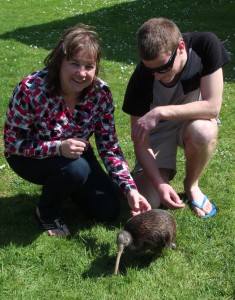
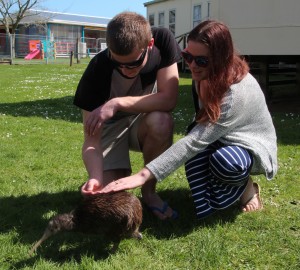
Recently I got to share an amazing experience with my children.
We got to meet Sparky a very special North Island brown kiwi.
Sparky arrived at the Whangarei Native Bird Recovery Centre in 2002 after losing his leg in an illegal gin trap.
Founders Robert and Robyn Webb started the Centre in 1992 and now rescue then care for and rehabilitate over 1,200 birds each year. They also spend many hours on education and community projects.
Sparky was three and a half months old when he arrived from a forest up in Keri Keri after being caught in a gin trap or possum trap. When it catches the kiwi the trap jaws are so powerful they will either break the leg or cut it nearly right off. The result of that is the kiwi would normally have to be put down.
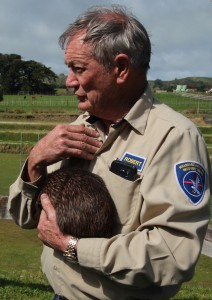
Lucky for Sparky it was decided he would be a kiwi ambassador and educate humans about wildlife conservation.
The 14 year old kiwi flies on an Air Nelson plane around New Zealand with his human dad Robert Webb giving the public an opportunity to meet their national icon.
“It is very important to share him with children and educate the next generation,” says Robert Webb.
With more education and improvements with technology, traps are now set on tree trunks off the ground hoping to eliminate any further damage to wildlife.
“Because they were never shown how to set the old type of traps off the ground suddenly it goes bang and catches a kiwi.”
The education day was organised by Karen Schumacher from the East Taranaki Environment Trust to enable the public to meet a real kiwi and show them the awesome kiwi conservation team work going in Taranaki.
Taranaki Kiwi Trust, Rotokare Trust, Department of Conservation, Taranaki Regional Council and Tiaki Te Mauri O Parininihi ki Waitotara all work together with the East Taranaki Environment Trust ensuring there are kiwis for future generations.
Karen explained that the East Taranaki Environment Trust focus is the Purangi Kiwi Project which is a large predator controlled area of 13,000 hectares where they protect kiwi in-situ.
“We have a public walk at our centre that people can come and enjoy. It showcases our project and people can learn about kiwi.
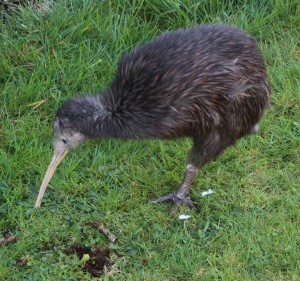
“The expectation is to a see a live kiwi but you don’t. They are nocturnal and they are wild. We hear them at night and in autumn when we do guided tours people can hear them but you won’t see them. That is why we decided four years ago to bring Sparky down and bring him into the schools.”
Their community outreach focus is “Kiwi are part of our community” with Sparky connecting our Kids and Kiwi.
“That is why we bring Sparky here and get all the other groups that are involved in kiwi work within Taranaki,” said Karen.
“The idea behind Kids and Kiwi is to bring them together and teach the next generation how to care for the land and wildlife.”
All the groups have individual roles within the larger end goal. Rotokare Scenic Reserve focus on the kohanga kiwi side of things with their creching; Department of Conservation and Taranaki Kiwi Trust focus is the mountain and with TKT also working with the farmers.
“I guess for Tara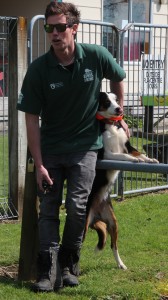 naki with all the kiwi projects, if you could imagine a jig-saw puzzle, we are all a part of the jigsaw but we all fit in a different place and do different things and have a different focus. So we all fit together and all have a role to play.”Over a couple of hours my children and I went around the various stations learning what each group had to offer. We enjoyed learning about kiwi aversion training for dogs and their owners. Dogs can smell a kiwi 100 metres away so it is important to train them not to go near kiwi.
naki with all the kiwi projects, if you could imagine a jig-saw puzzle, we are all a part of the jigsaw but we all fit in a different place and do different things and have a different focus. So we all fit together and all have a role to play.”Over a couple of hours my children and I went around the various stations learning what each group had to offer. We enjoyed learning about kiwi aversion training for dogs and their owners. Dogs can smell a kiwi 100 metres away so it is important to train them not to go near kiwi.
It was hard work getting any noise let alone a male kiwi call out of a shepherds whistle. We saw how the kiwi eggs are “candled” to see how old the chick is inside and were taught about the various traps available.
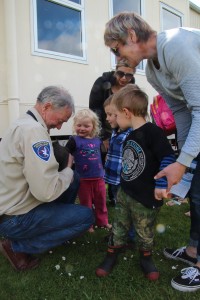
There were kiwi predators on display of which the common household cat was one of the worst and in some areas the pet dog as well. In Northland adult kiwi generally live to about 14 years old because of a huge dog problem. Taranaki kiwis have been known to live to about 50 years old.
Of course, the highlight of the day had to be meeting Sparky and being able to gently pat him. His feathers felt quite coarse on the top coat but were very soft down under that layer. He was very popular with young and old as he hopped around digging in the ground for worms. He can eat 200 – 300 worms a day!
It was such an amazing experience to be able to say that I have seen and touched a kiwi as many New Zealanders have not had the opportunity.
